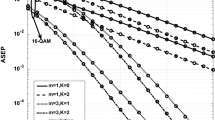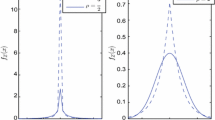Abstract
In this paper, a comparative study of the simulated symbol error rate (SER) with the theoretical SER of uncoded communication systems is made for selected modulation schemes with and without fading. Slow fading Weibull and Rayleigh channels are considered in this paper. The modulation schemes considered are (1) Binary Phase Shift Keying, (2) Quadrature Phase Shift Keying, (3) Orthogonal Frequency Shift Keying and (4) M-ary Quadrature Amplitude Modulation. A novel series expansion for SER of selected modulation schemes in slow fading Weibull channels is considered. In addition, closed-form expressions for the upper and lower bounds of the SER for the aforementioned modulation schemes in the presence of AWGN and Weibull fading channels are derived and plotted. The simulated results are validated by comparing them with their theoretical results, upper and lower bounds.












Similar content being viewed by others
References
Lee, E., and Messerschmitt, D., Digital Communications, Kluwer Academic Publishers, Boston, MA, third edition, 2003.
Verdu, S., Multiuser detection, Cambridge University Press, London, 1998.
Sklar, B., Digital Communications: Fundamentals and Applications, Pearson Education Asia, second edition, 2001.
Raju, S., and Bhaskar, V., “Performance analysis of various modulation schemes with and without fading,” International Journal of Electronics and Communication Engineering, vol. 2, no. 3, pp. 229–235, 2009.
Cheng, J., Tellambura, C., and Beaulieu, N. C., “Performance analysis of digital linear modulations on Weibull slow-fading channels,” IEEE Transactions on Communications, vol. 52, no. 8, pp. 1265–1268, 2004.
Lee, S., and Ko, Y., “Exact performance analysis of hybrid adaptive modulation schemes in multi-channel system,” IEEE Transactions on Communications, vol. 8, no. 6, pp. 3206–3215, 2009.
Ilyas, A., Ansari, E. A., and Akhtar, S., “Accurate SER/SER analysis and performance of different modulation schemes over wireless fading channels,” Science International, vol. 25, no. 2, pp. 367–374, 2013.
Talha, B., Patzold, M., and Primak, S., “Performance analysis of M-ary PSK modulation schemes over multiple double Rayleigh fading channels with EGC in cooperative networks,” 2010 IEEE International Conference on Communication Workshops (ICC), Capetown, South Africa, pp. 1–6, 2010.
Yang, D., Bai, Q., Zhang, Y., Ji, R., Li, Y., and Yang, Y., “Error performance analysis of multiuser CDMA systems with space-time coding in Rician fading channel,” Journal of Networks, vol. 9, no. 12, pp. 3462–3469, 2014.
Yang, D., Bai, Q., Zhang, Y., Ji, R., Li, Y., and Yang, Y., “Error performance analysis of multiuser CDMA systems with space-time coding in Rician fading channel,” Journal of Networks, vol. 9, no. 12, pp. 3462–3469, 2014.
Wang, T., and Kwon, H., “Multidimensional modulation for multipath fading channels: Performance analysis,” 2010 Military Communications Conference, San Jose, California, 2010.
Hajri, N., Youssef, N., and Patzold, M., “Performance analysis of binary DPSK modulation schemes over Hoyt fading channels,” 6 th International Symposium of Wireless Communication Systems, pp. 609–613, 2009.
Jain, G., and Dubey, R., “BER performance of OFDM system over Nakagami-m fading channels with different modulation schemes,” International Journal of Advanced Research in Computer Engineering and Technology, vol. 1, no. 6, 2012.
Sangeetha, M., Bhaskar, V., and Cyriac, A. R., “Performance analysis of downlink W-CDMA systems in Weibull and Lognormal fading channels using chaotic codes,” Wireless Personal Communications, vol. 74, no. 2, pp. 259–283, 2014.
Sangeetha, M., and Bhaskar, V., “Performance analysis of subspace based downlink channel estimation for W-CDMA systems using chaotic codes,” Wireless Personal Communications, vol. 71, no. 1, pp. 1–21, 2013.
Bhaskar, V., and Pai, L. S., “Performance analysis of MC-CDMA systems over Nakagami Hoyt fading,” Wireless Personal Communications, vol. 69, no. 4, pp. 1885–1898, 2013.
Pradeep, A. M., and Bhaskar, V., “Performance analysis of SEIGA in W-CDM systems over Weibull fading channels,” Wireless Personal Communications, vol. 64, no. 2, pp. 369–378, 2015.
Haykin, S., Digital Communications, John Wiley & Sons, NY, USA, second edition, 2001.
Proakis, J., Digital Communications, McGraw Hill, NY, USA, fourth edition, 2001.
Simon, M., and Alouini, M., Digital communications over fading channels, John Wiley & Sons, NY, USA, 2000.
Bhaskar, V., “Error probability distribution and density functions for Weibull fading channels with and without diversity combining,” International Journal of Wireless Information Networks, vol. 16, no. 1–2, pp. 91–97, 2009.
Gradshteyn, I., and Ryzhik, I., Table of Integrals, Series, and Products, Academic Press, San Diego, CA, fifth edition, 1994.
Author information
Authors and Affiliations
Corresponding author
Rights and permissions
About this article
Cite this article
Bhaskar, V., Raju, S. A Novel Series Expansion for Symbol Error Rates of Selected Modulation Schemes in Slow Fading Weibull Channels. Int J Wireless Inf Networks 22, 272–284 (2015). https://doi.org/10.1007/s10776-015-0279-7
Received:
Accepted:
Published:
Issue Date:
DOI: https://doi.org/10.1007/s10776-015-0279-7




